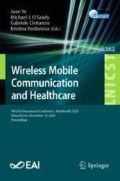Abstract
Mobile devices are becoming more pervasive in the monitoring of individuals’ health as device functionalities increase as does overall device prevalence in daily life. Therefore, it is necessary that these devices and their interactions are usable by individuals with diverse abilities and conditions. This paper assesses the usability of a neurocognitive assessment application by individuals with Parkinson’s Disease (PD) and proposes a design that focuses on the user interface, specifically on testing instructions, layouts, and subsequent user interactions. Further, we investigate potential benefits of cognitive interference (e.g., the addition of outside stimuli that intrude on task-related activity) on a user’s task performance. Understanding the population’s usability requirements and their performance on configured tasks allows for the formation of usable and objective neurocognitive assessments.
Access this chapter
Tax calculation will be finalised at checkout
Purchases are for personal use only
References
Chen, K.B., Savage, A.B., Chourasia, A.O., Wiegmann, D.A., Sesto, M.E.: Touch screen performance by individuals with and without motor control disabilities. Appl. Ergon. 44, 297–302 (2013)
Vo, A.: Usability in designing a mobile application for elderly users. Technical report (2019)
Xiong, J., Muraki, S.: Thumb performance of elderly users on smartphone touchscreen. SpringerPlus 5 (2016). Article number: 1218. https://doi.org/10.1186/s40064-016-2877-y
Vianello, A., Chittaro, L., Burigat, S., Budai, R.: MotorBrain: a mobile app for the assessment of users’ motor performance in neurology. Comput. Methods Programs Biomed. 143, 35–47 (2017)
Byrom, B., Wenzel, K., Pierce, J., Wenzel, K., Pierce, J.: Computerised clinical assessments: derived complex clinical endpoints from patient self-report data, pp. 179–202, May 2016
Nasreddine, Z.S., et al.: The montreal cognitive assessment, MoCA: a brief screening tool for mild cognitive impairment. J. Am. Geriatr. Soc. 53, 695–699 (2005)
Tombaugh, T.N., McIntyre, N.J.: The mini-mental state examination: a comprehensive review. J. Am. Geriatr. Soc. 40, 922–935 (1992)
Al-Heizan, M.O., Giles, G.M., Wolf, T.J., Edwards, D.F.: The construct validity of a new screening measure of functional cognitive ability: the menu task. Neuropsychological Rehabil. 30, 961–972 (2020)
Pettersson, A.F., Olsson, E., Wahlund, L.-O.: Motor function in subjects with mild cognitive impairment and early Alzheimer’s disease. Dement. Geriatr. Cogn. Disord. 19, 299–304 (2005)
Barbosa, A.F., et al.: Cognitive or cognitive-motor executive function tasks? Evaluating verbal fluency measures in people with Parkinson’s disease. BioMed Res. Int. 2017 (2017). Article ID: 7893975
Camp, C.J., Foss, J.W., O’Hanlon, A.M., Stevens, A.B.: Memory interventions for persons with dementia. Appl. Cogn. Psychol. 10, 193–210 (1996)
Ji, Y.G., Park, J.H., Lee, C., Yun, M.H.: A usability checklist for the usability evaluation of mobile phone user interface. Int. J. Hum.-Comput. Interact. 20(3), 207–231 (2006)
Löfgren, N., Conradsson, D., Rennie, L., Moe-Nilssen, R., Franzén, E.: The effects of integrated single- and dual-task training on automaticity and attention allocation in Parkinson’s disease: a secondary analysis from a randomized trial. Neuropsychology 33, 147–156 (2019)
Sarason, I.G., Sarason, B.R., Pierce, G.R.: Cognitive interference. In: Saklofske, D.H., Zeidner, M. (eds.) International Handbook of Personality and Intelligence. PIDF, pp. 285–296. Springer, Boston (1995). https://doi.org/10.1007/978-1-4757-5571-8_14
Scarpina, F., Tagini, S.: The stroop color and word test. Front. Psychol. 8, 557 (2017)
Wiegand, K., Patel, R.: Impact of motor impairment on full-screen touch interaction. Technical report (2015)
Sesto, M.E., Irwin, C.B., Chen, K.B., Chourasia, A.O., Wiegmann, D.A.: Effect of touch screen button size and spacing on touch characteristics of users with and without disabilities. Hum. Factors J. Hum. Factors Ergon. Soc. 54, 425–436 (2012)
Tsiodoulos, D., Kth, D.T.: Comparison of hamburger and bottom bar menu on mobile devices for three level navigation. Technical report (2016)
Templeton, J.M., Poellabauer, C., Schneider, S.: Enhancement of neurocognitive assessments using smartphone capabilities: systematic review. JMIR mHealth uHealth 8, e15517 (2020)
Kobayashi, M., Hiyama, A., Miura, T., Asakawa, C., Hirose, M., Ifukube, T.: Elderly user evaluation of mobile touchscreen interactions. In: Campos, P., Graham, N., Jorge, J., Nunes, N., Palanque, P., Winckler, M. (eds.) INTERACT 2011. LNCS, vol. 6946, pp. 83–99. Springer, Heidelberg (2011). https://doi.org/10.1007/978-3-642-23774-4_9
Di Rosa, E., Pischedda, D., Cherubini, P., Mapelli, D., Tamburin, S., Burigo, M.: Working memory in healthy aging and in Parkinson’s disease: evidence of interference effects. Aging Neuropsychol. Cogn. 24, 281–298 (2017)
LaPointe, L.L., Stierwalt, J.A.G., Maitland, C.G.: Talking while walking: cognitive loading and injurious falls in Parkinson’s disease. Int. J. Speech-Lang. Pathol. 12, 455–459 (2010)
Fellows, R.P., Dahmen, J., Cook, D., Schmitter-Edgecombe, M.: Multicomponent analysis of a digital trail making test. Clin. Neuropsychol. 31, 154–167 (2017)
Salthouse, T.A., et al.: Effects of aging on efficiency of task switching in a variant of the trail making test. Neuropsychology 14(1), 102–111 (2000)
Cook, D.J., Fellow, I., Schmitter-Edgecombe, M., Jönsson, L., Morant, A.V.: Technology-enabled assessment of functional health (2018)
Stuss, D.T., Stethem, L.L., Hugenholtz, H., Picton, T., Pivik, J., Richard, M.T.: Reaction time after head injury: fatigue, divided and focused attention, and consistency of performance. J. Neurol. Neurosurg. Psychiatry 52, 742–748 (1989)
Yadav, N., et al.: Portable neurological disease assessment using temporal analysis of speech. In: BCB 2015–6th ACM Conference on Bioinformatics, Computational Biology, and Health Informatics, pp. 77–85. Association for Computing Machinery Inc., September 2015
Christensen, A.L.: Neuropsychological experiences in neurotraumatology. In: von Wild, K.R.H. (ed.) Re-Engineering of the Damaged Brain and Spinal Cord. NEUROCHIRURGICA, vol. 93, pp. 195–198. Springer, Vienna (2005). https://doi.org/10.1007/3-211-27577-0_34
Author information
Authors and Affiliations
Corresponding author
Editor information
Editors and Affiliations
Rights and permissions
Copyright information
© 2021 ICST Institute for Computer Sciences, Social Informatics and Telecommunications Engineering
About this paper
Cite this paper
Templeton, J.M., Poellabauer, C., Schneider, S. (2021). Design of a Mobile-Based Neurological Assessment Tool for Aging Populations. In: Ye, J., O'Grady, M.J., Civitarese, G., Yordanova, K. (eds) Wireless Mobile Communication and Healthcare. MobiHealth 2020. Lecture Notes of the Institute for Computer Sciences, Social Informatics and Telecommunications Engineering, vol 362. Springer, Cham. https://doi.org/10.1007/978-3-030-70569-5_11
Download citation
DOI: https://doi.org/10.1007/978-3-030-70569-5_11
Published:
Publisher Name: Springer, Cham
Print ISBN: 978-3-030-70568-8
Online ISBN: 978-3-030-70569-5
eBook Packages: Computer ScienceComputer Science (R0)

